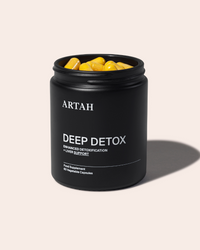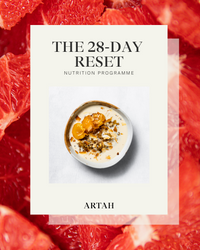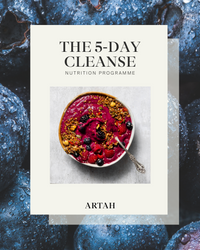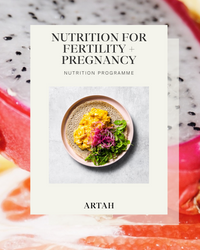6 Ways To Detox Your Routine
Lighter mornings, longer days, and rising temperatures make spring one of our favourite times of the year. In order to embrace everything that spring has to offer, we need to feel our best, so we’ve pulled together 6 easy – but impactful – ways to take advantage of spring energy and hit refresh.
Swap Out Winter Grains
Winter lends itself perfectly to heavier, heartier grains like barley, oats, millet and brown rice. As we transition into spring, we naturally start craving lighter meals, and switching to lighter grains is one of the first thing we do in the Artah kitchen. Quinoa and buckwheat are our spring staples; they’re higher in protein, vitamins, minerals, and fibre, but still have the satiating quality of heavier carbs. If you’re a oat or rice lover, don’t fret – these grains still have a place in the kitchen all year long, we just tweak their preparation for spring. Here are our some of our go-to spring swaps.
-
Swap out porridge and try overnight oats with chia; it’s lighter in carbs, higher in essential fat and fibre from the chia, and as it sits it starts to ferment, which is perfect for the microbiome.
-
Make your pasta half and half; we love using spiralized carrot, courgette, and squash mixed with our noodles to up the veg and make the meal a little lighter.
-
Try using quinoa in lieu of rice in dishes like curry, stews or saucy stir fries.
-
Cut your brown rice with cauli or broccoli rice to up your cruciferous polyphenols and halve the calories.
Give Your Liver a Boost
In Traditional Chinese Medicine, spring is a time of renewal. It’s governed by the liver and gallbladder, which influence the processing of energy, emotions and stress. The energetics of organs isn’t something we focus on in the west, but it’s easy to see a connection between their philosophy and what we know about the function of the liver and gallbladder. Together, these organs help with digestion and assimilation of nutrients (and therefore energy), as well as the detoxification and elimination of toxins. Here’s how we support our liver coming into spring.
-
Increase green and bitter foods, which stimulate bile production and provide us with tons of fibre, polyphenols and nutrients that fuel our microbiome.
-
If you’re feeling particularly stagnant, go for Deep Detox. It is packed with liver herbs like Milk Thistle, Turmeric, and Artichoke, alongside compounds like Alpha Lipoic Acid and N-Acetyl Cysteine that help replete essential antioxidants.
-
Try a cleanse: The 5 Day Cleanse is a quick, effective way to burst into spring energy and help give the body a break from a heavy winter.
Spring Clean Your Veggies
Whilst we’ve loved our potatoes and winter squash, it’s time to bid farewell to heavier vegetables and swap in some seasonality. Look for Artichoke, Beetroot, Carrots, Chicory, Kale, Morel Mushrooms, Radishes, Rhubarb, Rocket, Sorrel, Spinach, Spring Greens, Spring Onions, and Watercress, which incidentally, are all vegetables that are loved by the liver.
Reset your microbiome
After a long winter of darkness, heavy meals and one of the worst flu seasons in a decade, one of the first things to focus on is the microbiome. Whilst most of us are attuned to taking probiotics after antibiotic use, the link between common bugs like the flu or virus and the microbiome isn’t well publicised. Research has shown that both the flu and norovirus can cause intestinal inflammation that alters the health of our microbiome for months after the virus is gone. A study in the American Journal of Microbiology revealed alterations in the microbiome were still present 60 days after symptom cessation, results which provide an important reminder that recovery should be a core part of our wellness mindset. Here’s how we’re resetting our microbiome for spring.
-
Take a course of probiotic; try Enhanced Probiotic which has added digestive enzymes and polyphenols to help combat inflammation and improve digestion.
-
Try 30 days of fermented foods. Disclaimer: if your gut is feeling way out of balance, start slowly. Add a few tablespoons of wild fermented foods a few times a week, and build up to 6, ½ cup servings per week. The key to fermented foods is the quality, avoid ferments that have added sugar, colouring, or too much vinegar. Look for natural kimchi, sauerkraut, kefir, yogurts, and pickles.
Get Early Morning Light
Probably one of the most appreciated changes that comes with the season is the increase in morning light. Not only does it just feel better, it is great for our physiology. Bright morning light tells your body to suppress melatonin production and increase both cortisol (which helps us wake up) and serotonin. This change in morning hormones is transformational, but we can make it even better by trying to expose ourselves to light as soon as we wake up. Here are 3 ways sunlight improves our metabolic health.
-
It sets our circadian rhythm: morning light sends signals to the SCN, the part of our brain that is responsible for sleep-wake cycles, which in turn regulate our metabolic pathways.
-
It leads to better glucose control, lower anxiety and lower weight: signalling from the SCN regulate everything from food intake and insulin sensitivity to energy expenditure and mood.
-
It makes us happier. Exposure to morning light has been shown to up-regulate our serotonin, so it not only increases the amount of serotonin we produce, but it also promotes serotonin receptors in the brain.
-
Your challenge? Try to get outside, or at least in front of a window, for 10 minutes right after you wake up for 7 days in a row.
Implement Some IF
The colder months make it more challenging to follow any kind of fasting protocol, and with a natural increase in insulin resistance, sometimes it’s just too much. The adaptations we experience in spring, on the other hand, bring us back into balance, and with brighter, warmer days, our appetite can be much easier to manage. Intermittent fasting can be a great tool to use to get back into balance and is the perfect way to leverage spring energy.
-
If you’re new to IF, don’t go overboard. Start by reducing snacking and give yourself at least a week where you leave 12 full hours between dinner and the first thing you eat the next day. Once you’re comfortable with that, you can dip your toes in by trying 2, 16 hour fasts per week.
-
If you’re looking for something more structured and comprehensive, our 5 Day Cleanse and 21 Day Metabolic Reset have full nutrition protocols (and delicious recipes) that use IF to help you improve metabolic flexibility and increase your energy.
This article is for educational purposes only and the implementation of the theories and practices discussed is at the sole discretion of the individual. All advice given is not a substitute for medical advice, diagnosis, or treatment. If you have any concerns about your health, you should speak with your physician.


 SHOP ENHANCED PROBIOTIC
SHOP ENHANCED PROBIOTIC






































